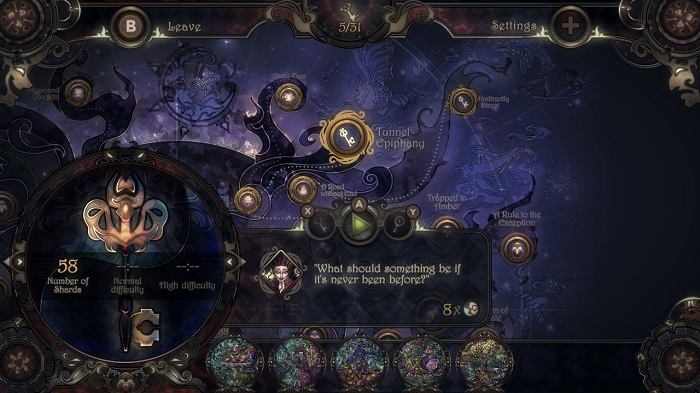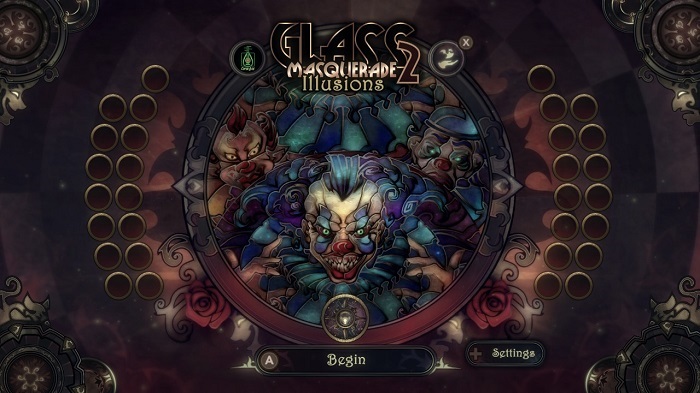Subjective:
Publisher Digerati and developer Onyx Lute present the stained-glass puzzler Glass Masquerade 2: Illusions for review (just Illusions moving forward). Illusions takes a crafting approach to jigsaw puzzles, presenting macabre and fantastical surroundings that slowly come into focus with each piece. A threadbare story moves the puzzles along from one set to the next as the piano, bells, and soft percussion punctuate the placement of pieces.
Objective:
Illusions is a puzzle assembly game of texture more than logical deduction. The metallic sheen and white splashes of color on the different tiles are evocative instead of representative since the image that’s being formed isn’t previewed or even initially clear. This is a far cry from standard puzzle assembly where you get a picture of what you’re trying to create in advance. It’s easy to feel frustrated with even the first puzzle, analyzing the curves and looking for the tiny imperfections in the remaining pieces that might clue you in to the next step toward a completed puzzle. But the tiny tonal reassurances, feeling out the pieces, and making sense of the textured colors will lead to success…if you’re patient enough.

Assessment:
Illusions is an upscale, and sometimes evocative, version of the kinds of puzzle books you can buy from the grocery store. There are probably few who remember leafing through a variety pack looking for their puzzle of choice, and Illusions cuts out the choice by providing one kind of puzzle extremely well. This means it’s going to be a tough sell for players looking for variety. But for a player like me, who appreciates the texture and care put into the puzzles, this is a colossal boon.
The two primary visual components of each puzzle help provide the challenge and enjoyment in assembly. The first is the stained-glass sheen, which gives each piece a reflective surface that shines when moved across the circular field. The second is the circular field itself as it forces the pieces into curves not common for puzzles. Finding out how each piece fits with each other means thinking less in a grid and more in texture. This leads to getting a feel for the colors, considering how the imperfections in each piece are tiny hints to the larger picture, and abandoning logical assembly as the image that’s being formed doesn’t always make sense.

It’s one of the only affective puzzle games I’ve played that still relies on assembly as its primary mechanic. This doesn’t always work, as the vague storyline and fables that front then bookend the puzzles are a sort of hamfisted attempt at intrigue. The visuals are also a bit too overdone at times. While there’s a lot of enjoyment from the sheen and stained-glass texture, it’s also difficult to get into that affective space where the player is feeling through the puzzle when everything is glinting or shifting at once. There were a few puzzles where the shimmer is too much and shapes that seemed to fit perfectly needed to be a handful of pixels over. This is rectified somewhat by the pieces snapping into place automatically when they’re close enough, but that also disrupts the balance of feeling through each field.
Still, those minor disruptions are worth the overall sensation of working through the puzzles. If you’re the type that needs hints, there’s a few pieces that are marked off to the side so that you can start from the edges of the sphere and work towards the middle. For the truly brave, and those who want to get lost in the circle, turning on the hard mode plus removing the hints really puts the player into the thick of making sense of the textured colors. I wasn’t brave enough to try this more than a couple of times, but the gentle plucking of the soundtrack combined with the way my brain was working overtime to cover the circle in even more abstract pieces made me want to return to those puzzles I already completed.
Game was played and reviewed using a provided review code of Glass Masquerade 2: Illusions for the Nintendo Switch
The Review
Glass Masquerade 2: Illusions
Glass Masquerade 2: Illusions is a traditional puzzle back. It also isn't the kind of game that will take you back in your memory to doing puzzles with grandma after a trip to the store. What it's doing is more challenging and, ultimately, evocative. Despite its sometimes overproduced visuals, the series of circular challenges will put sympathetic players into a deeply meditative state as they make sense of the textures in view. It's easy to get lost, but also intriguing enough to keep moving on even when the signs aren't so clear.
PROS
- The circular puzzles and fantastical art make for fantastic assembly as the image that's being formed is not hinted at but always arrives naturally from the surroundings.
- Gorgeous plunking soundtrack keeps progress steadily marching forward even when the pieces don't have an initially coherent path to completion.
- Combination of reflective colors and metallic edges keep the player feeling through pieces to make emotional sense of the colorful texture instead of clunking down parts robotically.
CONS
- The overproduced visuals are sometimes a detriment and force the player to guess while hoping the snap mechanic will put the pieces in the correct location.



